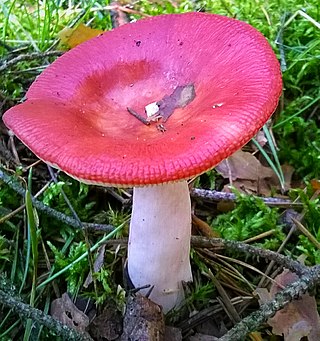
Russula emetica, commonly known as the sickener, emetic russula, or vomiting russula, is a basidiomycete mushroom, and the type species of the genus Russula. It has a red, convex to flat cap up to 8.5 cm (3.3 in) in diameter, with a cuticle that can be peeled off almost to the centre. The gills are white to pale cream, and closely spaced. A smooth white stem measures up to 10.5 cm (4.1 in) long and 2.4 cm (0.9 in) thick. First described in 1774, the mushroom has a wide distribution in the Northern Hemisphere, where it grows on the ground in damp woodlands in a mycorrhizal association with conifers, especially pine.

An annulus is the ring-like or collar-like structure sometimes found on the stipe of some species of mushrooms. The annulus represents the remnants of the partial veil, after it has ruptured to expose the gills or other spore-producing surface. It can also be called a ring which is what the Latin word annulus directly translates as. The modern usage of the Latin word originates from the early days of botany and mycology when species descriptions were only written in Latin. Outside of the formal setting of scientific publications which still have a Latin requirement, it will often just be referred to as a ring or stem ring in field guides and on identification websites.

Leratiomyces ceres, commonly known as the chip cherry or redlead roundhead, is mushroom which has a bright red to orange cap and dark purple-brown spore deposit. It is usually found growing gregariously on wood chips and is one of the most common and most distinctive mushrooms found in that habitat. It is common on wood chips and lawns in North America, Europe, Australia, New Zealand and elsewhere. The name Stropharia aurantiaca has been used extensively but incorrectly for this mushroom.

Stropharia aeruginosa, commonly known as the blue-green stropharia, or verdigris agaric, is a medium-sized green, slimy woodland mushroom, found on lawns, mulch and woodland from spring to autumn. The edibility of this mushroom is controversial - some sources claim that it is edible, while others claim it to be poisonous, although effects are little known and its toxic constituents undescribed.
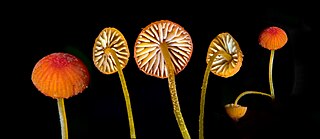
Mycena acicula, commonly known as the orange bonnet, or the coral spring Mycena, is a species of fungus in the family Mycenaceae. It is found in Asia, the Caribbean, North America and Europe. The fruit bodies, or mushrooms, of the fungus grow on dead twigs and other woody debris of forest floors, especially along streams and other wet places. They have small orange-red caps, up to 1 cm (0.4 in) in diameter, held by slender yellowish stems up to 6 cm (2.4 in) long. The gills are pale yellow with a whitish edge. Several other Mycena species look similar, but may be distinguished by differences in size and/or microscopic characteristics. M. acicula is considered inedible because of its small size.

Pholiota flammans, commonly known as the yellow pholiota, the flaming Pholiota, or the flame scalecap, is a basidiomycete agaric mushroom of the genus Pholiota. Its fruit body is golden-yellow in color throughout, while its cap and stem are covered in sharp scales. As it is a saprobic fungus, the fruit bodies typically appear in clusters on the stumps of dead coniferous trees. P. flammans is distributed throughout Europe, North America, and Asia in boreal and temperate regions. Its edibility has not been clarified.

Cortinarius cinnamomeus, also known as the cinnamon webcap, is a basidiomycete mushroom of the genus Cortinarius. The fungus produces brown fruit bodies with caps up to 6 cm (2.4 in) wide and stems up to 12 cm (4.7 in) long. The closely crowded gills underside the cap are initially yellow before turning brown. Cortinarius cinnamomeus is common in damp places in coniferous forests. It is distributed throughout the temperate zone of the Northern Hemisphere.

Amanita ravenelii, commonly known as the pinecone lepidella, is a species of fungus in the family Amanitaceae. The whitish fruit bodies are medium to large, with caps up to 17 centimetres wide, and stems up to 25 cm (10 in) long. The cap surface has large warts and the stem has a scaly, bulbous base. The mushrooms have a unique chlorine like odor.
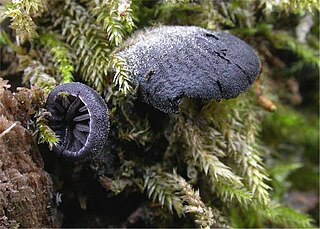
Resupinatus applicatus, commonly known as the smoked oysterling or the black jelly oyster, is a species of fungus in the family Tricholomataceae, and the type species of the genus Resupinatus. First described in 1786 as Agaricus applicatus by August Johann Georg Karl Batsch, it was transferred to Resupinatus by Samuel Frederick Gray in 1821.

Collybia cirrhata is a species of fungus in the family Tricholomataceae of the order Agaricales. The species was first described in the scientific literature in 1786, but was not validly named until 1803. Found in Europe, Northern Eurasia, and North America, it is known from temperate, boreal, and alpine or arctic habitats. It is a saprobic species that grows in clusters on the decaying or blackened remains of other mushrooms. The fruit bodies are small, with whitish convex to flattened caps up to 11 mm in diameter, narrow white gills, and slender whitish stems 8–25 mm long and up to 2 mm (0.08 in) thick. C. cirrhata can be distinguished from the other two members of Collybia by the absence of a sclerotium at the base of the stem. The mushroom is of unknown edibility.

Hygrophorus olivaceoalbus, commonly known as the olive wax cap or sheathed waxy cap, is a species of fungus in the genus Hygrophorus. The fruit bodies (mushrooms) appear from midsummer to late autumn under conifers in North American and Eurasian mountain forests. The mushrooms have olive-brown, slimy caps with dark streaks and a dark umbo; the caps measure 3 to 12 cm in diameter. Other characteristic features include a slimy stem up to 12 cm long that is spotted with ragged scales up to a ring-like zone. As its name implies, the mushroom has a waxy cap and gills. It is native to North America and across the northern regions of Europe. According to a publication by the Council of Europe, the fungus is nearly extinct in France.
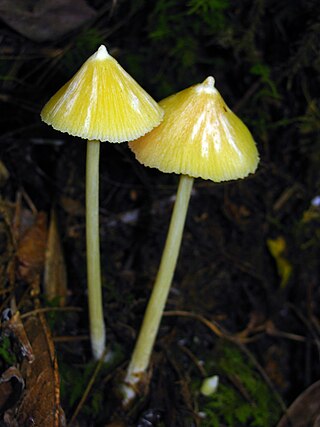
Entoloma murrayi, commonly known as the yellow unicorn Entoloma or the unicorn pinkgill, is a species of fungus in the Entolomataceae family. First described from New England (USA) in 1859, the species is found in eastern North America, Central and South America, and southeast Asia, where it grows on the ground in wet coniferous and deciduous forests. The fungus produces yellow mushrooms that have a characteristic sharp umbo on the top of a conical cap. The mushroom is inedible and may be poisonous. Other similar species can be distinguished from E. murrayi by differences in color, morphology, or microscopic characteristics.

Phaeocollybia christinae, commonly known as Christina's rootshank, is a species of fungus in the family Cortinariaceae. Found in the woodlands of Europe and eastern North America, it typically grows in sandy soil near conifer trees, especially spruce. The fruit bodies are characterized by a brownish cap with a pointed umbo, and a long stem that extends deeply into the soil.
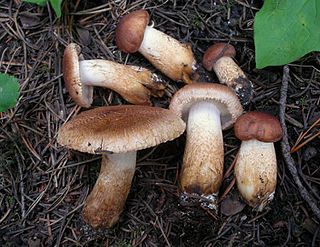
Tricholoma vaccinum, commonly known as the russet scaly tricholoma, the scaly knight, or the fuzztop, is a fungus of the agaric genus Tricholoma. It produces medium-sized fruit bodies (mushrooms) that have a distinctive hairy reddish-brown cap with a shaggy margin when young. The cap, which can reach a diameter of up to 6.5 cm (2.6 in) wide, breaks up into flattened scales in maturity. It has cream-buff to pinkish gills with brown spots. Its fibrous, hollow stipe is white above and reddish brown below, and measures 4 to 7.5 cm long. Although young fruit bodies have a partial veil, it does not leave a ring on the stipe.

Protostropharia, is a coprophilous agaric fungal genus that produces glutinous, mostly yellowish to yellow brown fruit bodies. Characteristically most form chrysocystidia and rather large, smooth, violaceous basidiospores each with a prominent germ pore. It is differentiated from Stropharia by production of astrocystidia on its mycelium rather than by acanthocytes that Stropharia produces. Phylogenetically, Protostropharia is distinct from Stropharia, Pholiota, and Leratiomyces. Two species, P. luteonitens and P. tuberosa, form pseudosclerotia in the dung substrates.
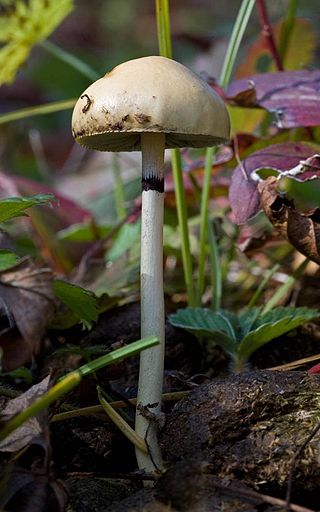
Protostropharia alcis is a species of coprophilous agaric fungus in the family Strophariaceae. The fungus produces fruit bodies on moose, elk, and deer dung. The species has been recorded in Europe, Canada and Brazil.

Tricholoma ustale, commonly known as the burnt knight, is a species of mushroom in the large genus Tricholoma. It is found in Asia, Europe, and North America, though those from North America may represent one or more different species.

Hygrophorus russula, commonly known as the pinkmottle woodwax, false russula, or russula-like waxy cap, is a fungus native to North America and Europe.

Stropharia caerulea, commonly known as the blue roundhead, is a species of mushroom forming fungus in the family Strophariaceae. It is a somewhat common species found in Europe and North America, where it grows as a saprophyte in meadows, roadsides, hedgerows, gardens, and woodchip mulch. S. caerulea was officially described to science in 1979, although it was known to be a distinct species for about two centuries before that. The scientific name Stropharia cyanea, as defined by Tuomikoski in 1953, and used by several later authors, is a synonym of S. caerulea.

Coprinopsis nivea is a species of mushroom producing fungus in the family Psathyrellaceae. It is commonly known as the snowy inkcap.





















